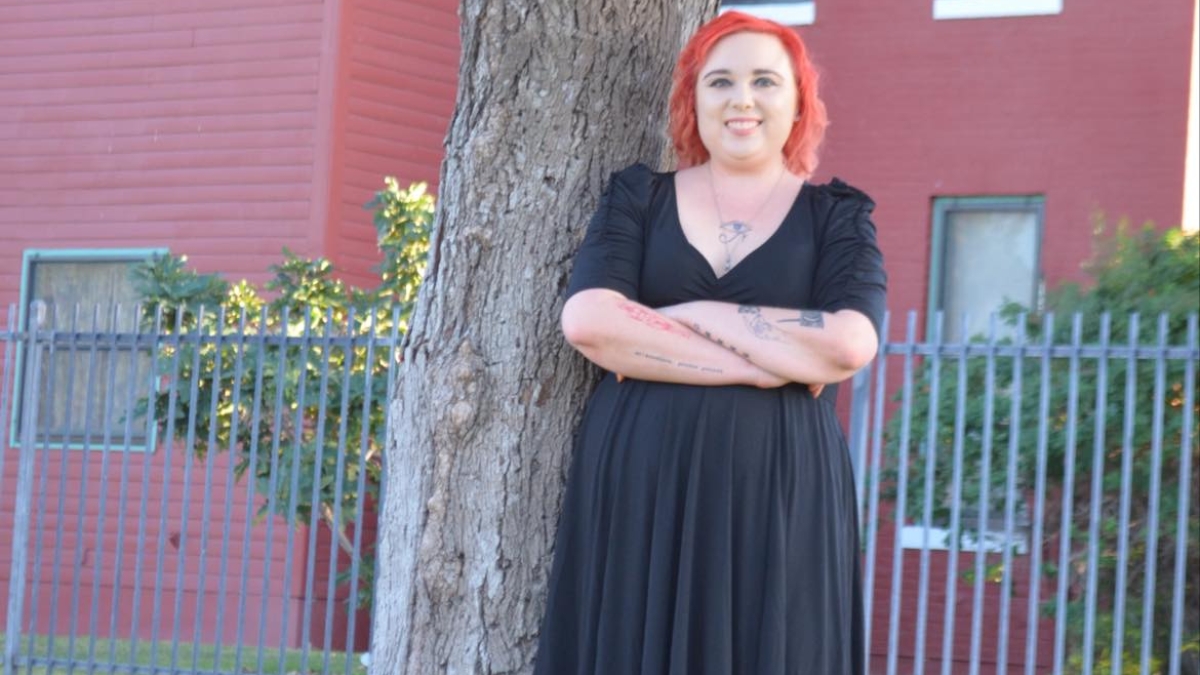Outstanding grad combines art with research for social change

Ella Burrus is the New College of Interdisciplinary Arts and Sciences Outstanding Graduate student for fall 2021.
Editor's note: This story is part of a series of profiles of notable fall 2021 graduates.
For Ella Burrus, being an artist has never been just a hobby.
As the fall 2021 New College of Interdisciplinary Arts and Sciences Outstanding Graduate Student prepares to walk the stage this December with a Master of Arts in social justice and human rights from Arizona State University’s School of Social and Behavioral Sciences, she looks forward to continuing to seamlessly incorporate art into her advocacy and activism.
“I am so grateful for the ability and the opportunity to combine art with research, and explore that in the ways that I feel can make a difference,” Burrus said.
She said she is proud to obtain a graduate degree from ASU and revels in the freedom that the degree program gave her to explore her interests and use them to further her understanding of social justice and human rights.
“Studying social justice is important because it gives us the knowledge about what types of issues and problems need to be addressed, and it serves as that catalyst for those who do want to be change-makers in society,” Burrus said.
As she reflected on her time in the graduate program, Burrus said that she is grateful for the opportunity to learn in the classroom with her peers, despite the uncertainty of the pandemic.
“(It) has shown me how much I value the in-person learning experience,” she said.
Burrus uses her collegiate experiences to implore other graduate students to be open to everything that may come their way — both good and bad.
“It is important to know that you will experience ups and downs, but that as long as you have your 'why,' essentially the reason why you entered grad school, the things that drive you, along with not being afraid to reach out for support and mentorship, you will make it,” she said.
Question: Why did you choose ASU?
Answer: During my senior year of high school, I applied to Arizona State University, specifically to Barrett, the Honors College. I could not afford living on campus and knew I would be commuting to whichever school I went to, and ASU was the closest school to my home. I was accepted into Barrett at all four campuses and was even offered the Dorrance Scholarship for a full ride, including housing, to attend Barrett at the Tempe campus. However, for a number of reasons, I ended up enrolling at the ASU West campus using the Provost Merit Scholarship.
Q: What's something you learned in the social justice and human rights program that changed your perspective?
A: During my time in the social justice and human rights (SJHR) MA ground program, my perspective on my own trajectory changed. I feel that the majority of students, undergrad and grad, start programs assuming they know what they want and what they will get by the completion of the program. However, undergoing graduate school, especially between semesters in 2020–2021, I learned that anything can happen, and that what we think will happen, most of the time actually turns out differently. My perspective going into the SJHR program is certainly not the same perspective I have now as I exit the program.
Q: If someone gave you $40 million to solve one problem on our planet, what would you tackle?
A: Although money has the power to improve things, I think that the most meaningful change comes as a result of change in perspective. So many of the world’s problems would be resolved if people were open to different ways of thought. I feel like universities (at their best) have the power to introduce others to new ways of thinking. However, the reality is that the majority of individuals do not have access to the university environment. That said, I would use $40 million in an attempt to spread this type of awareness to places outside the university, reaching a larger audience. This type of initiative can come about by funding programming in places such as low-income or rural neighborhoods. Also, the programming should be delivered in ways that match the community and that community members would enjoy learning from.
More Arts, humanities and education

ASU professor's project helps students learn complex topics
One of Arizona State University’s top professors is using her signature research project to improve how college students learn…

Award-winning playwright shares her scriptwriting process with ASU students
Actions speak louder than words. That’s why award-winning playwright Y York is workshopping her latest play, "Becoming…

Exceeding great expectations in downtown Mesa
Anyone visiting downtown Mesa over the past couple of years has a lot to rave about: The bevy of restaurants, unique local shops…

